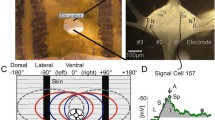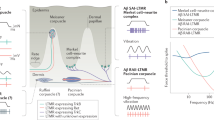Abstract
-
1.
The maximum force exerted against an isometric force transducer by 6 leeches weighing 2.6–3.7 g, as they squeezed through apertures of different widths varied inversely with aperture width.
-
2.
T cells in the leech skin code for velocity of indentation, not pressure or displacement. The frequency with which T cells fire is best described by two log functions, one for low, another for fast indentations. T cells responded to indentation velocities down to 10 μms−1.
-
3.
The average threshold pressure for 5 P cells was 150 kPa and for 5 N cells was 521 kPa.
-
4.
We conclude from these data that when leeches explore their mechanical environment and initiate contact with external objects, the threshold pressure for N cells is rarely crossed. Of the three classes of mechanoreceptor, T cells are the main modality through which leeches obtain contact information, though P cells may occasionally be recruited for local pressure peaks.
Similar content being viewed by others
References
Biedenbach MA (1973) Functional properties and projection areas of cutaneous receptors in catfish. J Comp Physiol 84: 227–250
Blackshaw SE (1981) Morphology and distribution of touch cell terminals in the skin of the leech. J Physiol (Lond) 320: 219–228
Brodfuehrer PD, Friesen WO (1986a) Initiation of swimming activity by trigger neurons in the leech suboesophageal ganglion. I. Output connections of Tr 1 and Tr 2. J Comp Physiol A 159: 489–502
Brodfuehrer PD, Friesen WO (1986b) Initiation of swimming activity by trigger neurons in the leech subosoephageal ganglion. II. Role of segmental swim-initiating interneurons. J Comp Physiol A 159: 503–510
Brodfuehrer PD, Friesen WO (1986c) Initiation of swimming activity by trigger neurons in the leech subosoephageal ganglion. III. Sensory input to Tr 1 and Tr 2. J Comp Physiol A 159: 511–512
Bush BMH, Roberts A (1971) Coxal muscle receptors in the crab: the receptor potential of S and T fibres in response to ramp stretches. J Exp Biol 55: 813–832
Darian-Smith I, Oke L (1980) Peripheral neural representation of the spatial frequency of a grating moving across the monkey's finger pad. J Physiol (Lond) 309: 117–133
Darian-Smith I, Davidson I, Johnson KO (1980) Peripheral neural representation of spatial dimensions of a textured surface moving across the monkey's finger pad. J Physiol (Lond) 309: 135–146
Debski EA, Friesen WO (1985) Habituation of swimming activity in the medicinal leech. J Exp Biol 116: 169–188
Debski EA, Friesen WO (1987) Intracellular stimulation of sensory cells elicits swimming activity in the medicinal leech. J Comp Physiol A 160: 447–457
Elliott EJ (1985) Leech lip sensilla detect NaCl and arginine in blood. Chem Senses 10: 461
Elliott EJ (1986) Chemosensory stimuli in feeding behaviour of the leech Hirudo medicinalis J. Comp Physiol A 159: 391–401
Essick GK, Whitsel BL (1985) Factors influencing cutaneous directional sensitivity: a correlative psychophysical and neurophysiological investigation. Brain Res Rev 10: 213–230
Essick GK, Bredhoeft KR, McLaughlin DF, Szanisko JA (1991) Directional sensitivity along the upper limb in humans. Somatosens Mot Res 8: 13–22
Frieson WO (1981) Physiology of water motion detection in the medicinal leech. J Exp Biol 92: 255–275
Friesen WO, Poon M, Stent GS (1978) Neuronal control of leech swimming movements: interactions between cell 60 and previously described oscillator neurons. J Exp Biol 75: 25–43
Gardner EP, Palmer CI (1989) Stimulation of motion of the skin. 1. Receptor fields and temporal coding by cutaneous mechanoreceptors of OPTACON pulses delivered to the hand. J Neurophysiol 62: 1410–1436
Gardner EP, Sklar B (1994) Discrimination of the direction of motion on the human hand: a psychophysical study of stimulation parameters. J Neurophysiol 71: 2414–2429
Gascoigne L, McVean AR (1991) Water movement sensitive cells in leech CNS. Phil Trans R Soc B 332: 261–270
Gee W (1913) The behaviour of leeches with especial reference to its modifiability. Univ California Publ Zool 11: 197–305
Goodwin AW, Morley JW (1987) Sinusoidal movement of a grating across the monkey's finger pad: representation of grating and movement features in afferent fiber responses. J Neurosci 7: 2168–2180
Kretz JR, Stent GS, Kristan WB (1976) Photosensory input pathways in the medicinal leech. J Comp Physiol 106: 1–37
Kristan WB (1982) Sensory and motor neurones responsible for the local bending response in leeches. J Exp Biol 96: 161–180
Kristan WB, McGirr SJ, Simpson CV (1982) Neuronal control of swimming in the medicinal leech. IV. Identification of a network of oscillatory interneurons. J Exp Biol 96: 161–180
Lamb GD (1983) Tactile discrimination of textured surfaces: peripheral neural coding in the monkey. J Physiol (Lond) 338: 567–587
Lasansky A, Fuortes MGF (1969) The site of origin of electrical properties in visual cells of the leech, Hirudo medicinalis. J Cell Biol 42: 241–252
Lockery SR, Kristan WB (1990a) Distributed processing of sensory information in the leech. I. Input-output relations of the local bending reflex. J Neurosci 10: 1811–1815
Lockery SR, Kristan WB (1990b) Distributed processing of sensory information in the leech. II. Identification of interneurones contributing to the local bending reflex. J Neurosci 10: 1816–1829
Magni F, Pellegrino M (1978) Neural mechanisms underlying the segmental and generalised cord shortening in the leech. J Comp Physiol 124: 339–351
Mathews G, Wickelgren WO (1978) Trigeminal sensory neurons of the sea lamprey. J Comp Physiol 123: 329–333
McVean A (1989) Velocity and displacement receptors in the skin of hagfish Myxine glutinosa. J Zool Lond 219: 251–267
Morley JW, Goodwin AW (1987) Sinusoidal movement of a grating across the monkey's finger pad: temporal patterns of afferent fiber responses. J Neurosci 7: 2181–2191
Muller KJ, Nicholls JG, Stent GS (1981) Neurobiology of the leech Cold Spring Harbor, New York
Nicholls JG, Baylor DA (1968) Specific modalities and receptive fields of sensory neurons in the CNS of the leech. J Neurophysiol 31: 740–756
Ort CA, Kristan WB, Stent GS (1974) Neuronal control of swimming in the medicinal leech. II. Identification and connections of motor neurons. J Comp Physiol 94: 121–154
Peterson EL (1983) Visual processing in the leech nervous system Nature 303: 240–242
Roberts A (1980) The function of two types of mechanoreceptive ‘free’ nerve endings in the head skin of amphibian embryos. J Comp Physiol 135: 341–348
Roberts A, Blight AR (1975) Anatomy, physiology and behavioural role of sensory nerve endings in the cement gland of embryonic Xenopus. Proc R Soc (Lond) B 192: 111–127
Stent GS, Kristan WB, Friesen WO, Ort CA, Poon M, Calabrese RC (1978) Neuronal generation of the leech swimming movement. Science 200: 1348–1357
Weeks JC (1982a) Synaptic basis of swim initiation in the leech (Hirudo medicinalis): I. Connections of a swim-initiating neuron (cell 204) with motor-neurons and pattern generating ‘oscillator’ neurons. J Comp Physiol 148: 253–264
Weeks JC (1982b) Synaptic basis of swim initiation in the leech (Hirudo medicinalis): II. A pattern-generating neuron (cell 208) which indicates motor effects of swim-initiating neurons J Comp Physiol 148: 265–280
Weeks JC, Kristan WB (1978) Initiation, maintenance and modulation of swimming in the medicinal leech by the activity of a single neuron. J Exp Biol 77: 71–88
Uttal WR (1973) The psychobiology of sensory coding. Physiological Psychology Series. Harper and Row, New York
Yau King-Wai (1976) Physiological properties and receptive fields of mechanosensory neurons in the head ganglion of the leech: comparison with homologous cells in segmental ganglia. J Physiol (Lond) 263: 489–512
Author information
Authors and Affiliations
Rights and permissions
About this article
Cite this article
Carlton, T., McVean, A. The role of touch, pressure and nociceptive mechanoreceptors of the leech in unrestrained behaviour. J Comp Physiol A 177, 781–791 (1995). https://doi.org/10.1007/BF00187637
Accepted:
Issue Date:
DOI: https://doi.org/10.1007/BF00187637




